Best bird food 2025: Feed those hungry bird bellies
Putting out the best bird food is going to make you so many friends – of the feathered variety
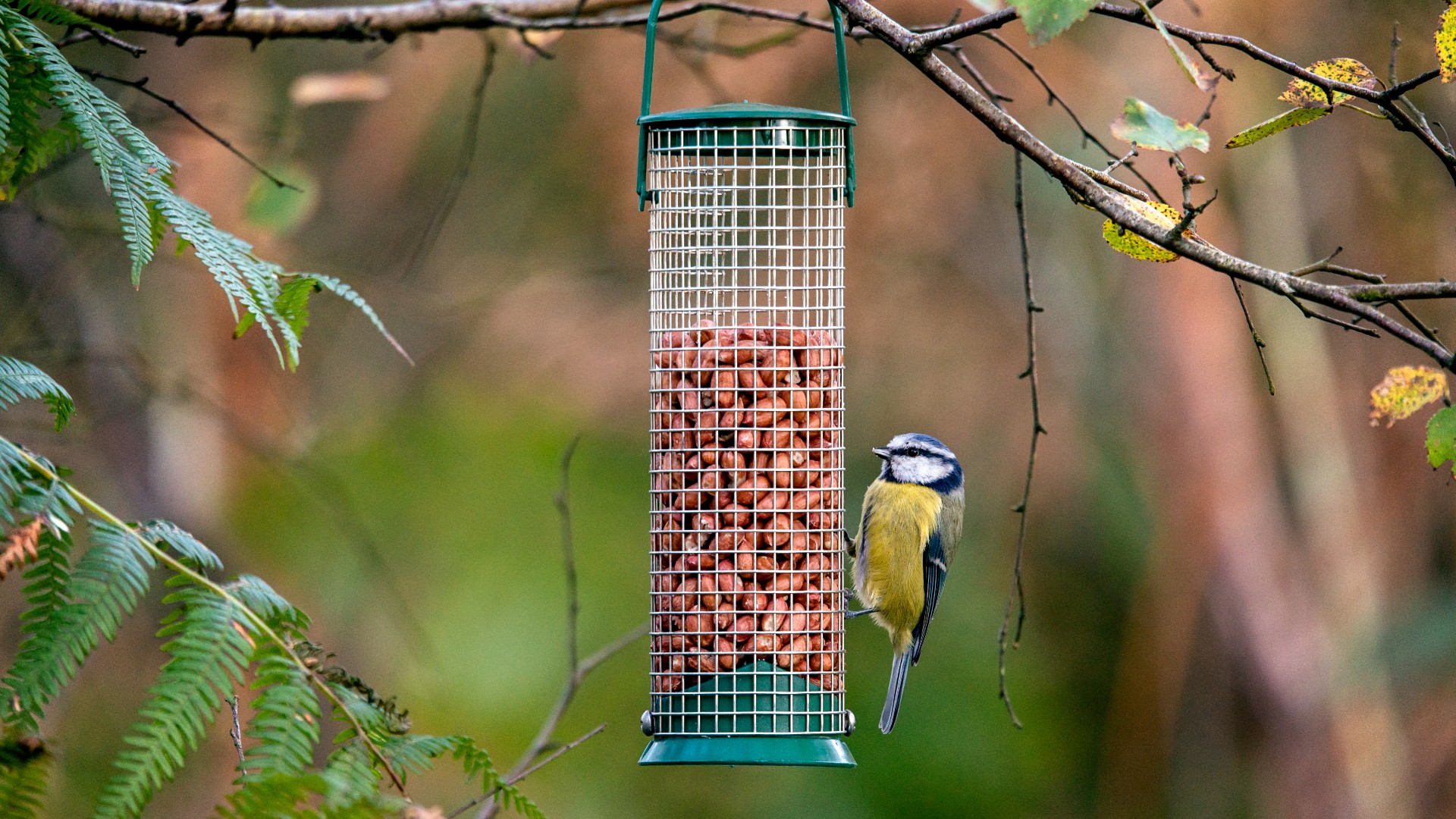
You will need to put out the best bird food if you want to attract winged visitors to your garden. But before you run to the nearest store to grab your supplies, it’s worth thinking about which birds you want to attract and the kinds of food they are going to enjoy the most.
Some foods will be more suitable for some birds than others. Fill the best bird feeders with tiny nyjer seeds, for example, and you’ll attract finches because their beaks are best equipped to eat it. Put out mealworms and you’re going to see more wagtails, blackbirds and robins.
Peanuts are great for nuthatches and tits while thrushes and wrens will enjoy fat balls. But seed mixes have the widest appeal if you simply want to attract as many birds as possible.
“There are a variety of bird food options available which suit different species, so most people offer a mixture,” expert vet Dr Rebecca MacMillan says.
Bear in mind that you will need to know how to keep squirrels out of your bird feeder so that all of the food goes to its intended audience and make sure the food doesn’t become contaminated by regularly cleaning the feeder. And feel free to experiment. You don’t need to stick with just one brand of best bird food: mix it up and you may be surprised at which birds will visit.
The best bird food 2025

Best seed
Aimed at feeding small songbirds, this bag of seed – apparently containing 150,000 seeds per pound – will prove perfect if you’re looking to attract finches. It’s recommended that you place it in a finch feeder to deter large birds from poking their beaks through the small holes. And since the seeds are entirely natural and high in both fat and protein, you can rest assured that it’s not only going to be tasty but good for the birds as well.
With no growth, you don’t have to worry about the seeds sprouting although some users report they can dry out. Even so, you may not even get to that stage because the seeds are sure to prove popular. Lots of users say their feeders end up being covered with small birds eager to gobble it up and that tends to be all the recommendation you’d need.
Reasons to buy: You get loads of seeds that birds absolutely love in a resealable bag for a reasonable price.
Reasons to avoid: There are potential issues with seeds drying out but store the bags well and you should be fine.

Best mix
Containing all natural ingredients with no artificial preservatives or additives, this mix contains absolutely no waste. Each bag has a finely cut blend of sunflower kernels, as well as pieces of pistachio, almond, peanuts and pumpkin seeds. There’s white proso millet too. What’s more, the mix has been based on research to ensure that birds will find it attractive and tasty.
All of the shells and hulls from the nuts and seeds have been removed and the manufacturer assures that the bags don’t contain any filler. The nuts also provide a natural source of Vitamin E so you can rest assured that you’re doing the birds a lot of good. You’ll be aiding a bird’s digestion, for a start.
As such, a wide variety of songbirds should flock to the mix and the maker even says that it will attract bluebirds which usually only visit meal feeders. With good user reviews, it’s as fine a product as you’ll find.
Reasons to buy: The mix is high quality and care has been taken to ensure every beakfull provides nutrition.
Reasons to avoid: If you’re looking to attract larger birds, you may want to consider a different product.
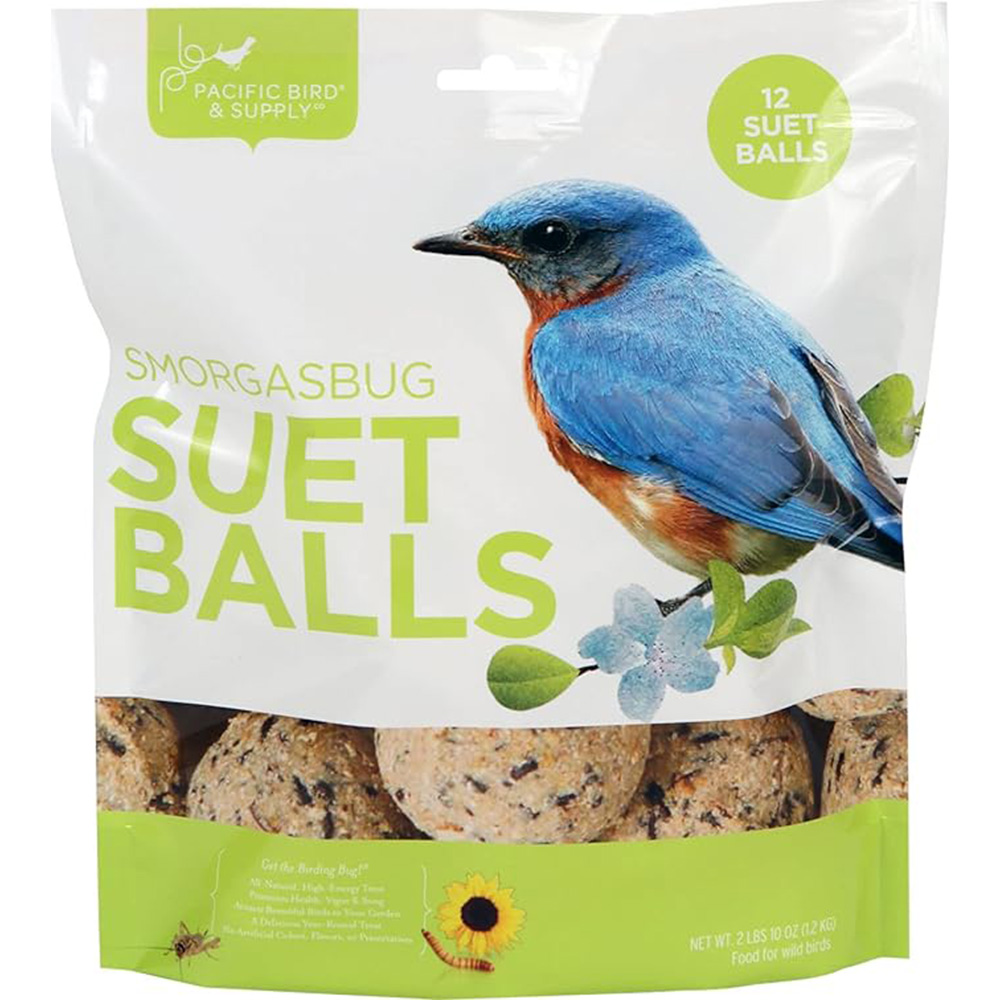
Best suet balls
Ideal for the winter, these suet balls will provide an abundance of protein and energy. They’ll fit well in a suet ball feeder and they don’t contain any artificial colors, flavors or preservatives, making them a great all-round, practical food. They come with the bonus of containing whole insects too which is sure to go down a treat with birds even if they generally don’t like suet. In fact, that does seem to be the case with many users saying birds simply adore them.
With these, you’re going to be attracting finches, chickadees, flickers, wrens and woodpeckers but it’s also worth pointing out that there are other suet ball varieties which may prove more appealing to your target bird. For example, there are suet balls containing mealworm and mixed nut with another including insects and hot pepper. The latter is particularly great for woodpeckers and it should help to keep squirrels at bay too.
Reasons to buy: You get 12 quality suet balls which can attract a wide range of bird species to your yard.
Reasons to avoid: The suet balls can be a little brittle so if the packet gets crushed, you can end up with small pieces.
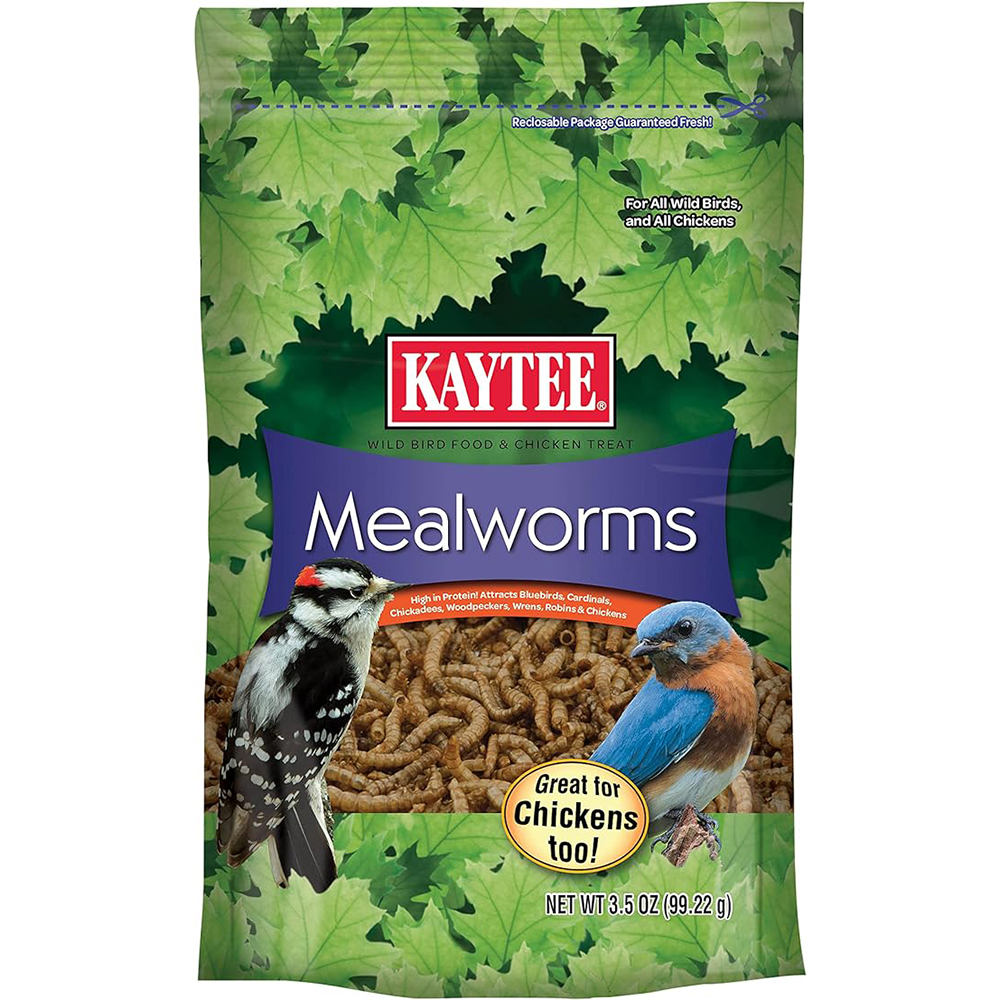
Best mealworms
With a resealable bag of nothing more than dried mealworms, you really can’t go wrong. Put them out, generally on a bird table, and you’ll find bluebirds, wrens, robins, cardinals, woodpeckers and chickadees fly over in droves, instinctively knowing that they’re going to get a high-protein feed.
In this case, the mealworms have been oven dried which helps them to maintain their finest quality and since nothing else has been added, you can rest assured that wild birds are getting the most natural of meals. Of course, you also have the advantage that you’re not handling live mealworms which some people may find off putting. The nutritional value is the same whether they’re dried or live so you don’t need to worry that you’re short-changing your visiting birds in any way.
Reasons to buy: They’re dried rather than live and you’re getting a big, convenient resealable bag of them.
Reasons to avoid: You’re encouraged to mix them with bird seed so that could make the overall feed a little more expensive.
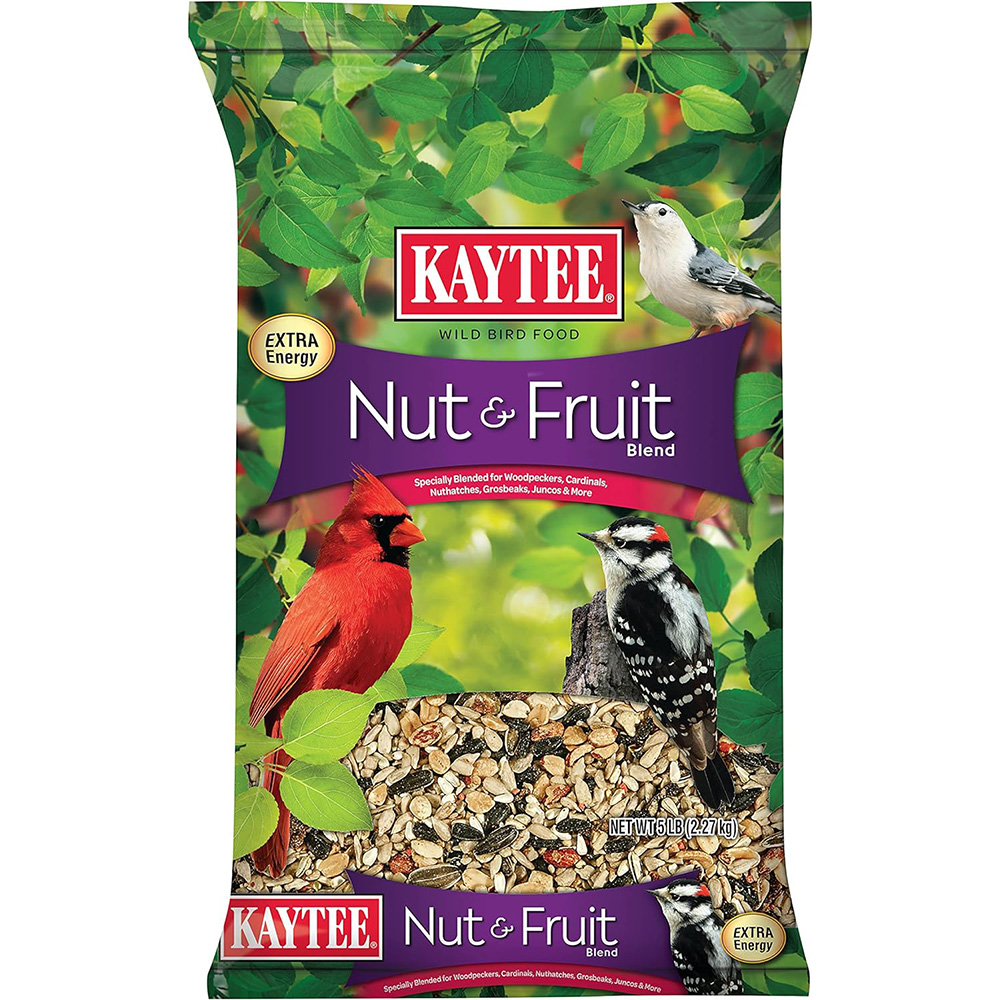
Best fruit blend
If you’re looking for a high energy food for wild birds, then this pack is a great fit. As the packaging says, nothing offers more energy pound-for-pound than fruit and nuts and that’s what you’re getting here – lots of peanuts, mixed feed nuts, raisins, dried cherries and fruit pieces among the sunflower, safflower and hulled pumpkin seeds. That provides about 14% protein, 30.5% crude fat and 14% fiber.
If there is any concern with this pack then it’s the fact it also has an artificial cherry flavour and that most of the pack is actually seed rather than fruit and nut. But the proof is definitely in the eating and on that score we have no qualms. Birds generally love this fruity blend and, while squirrels will also enjoy munching away which could be off-putting, you should attract a wide variety of feathered friends.
Reasons to buy: You’re able to give wild birds fruit and nuts as well as sunflower seeds, a combo which is good for health.
Reasons to avoid: You may find that the blend is attractive to squirrels too so have an anti-squirrel strategy in place.
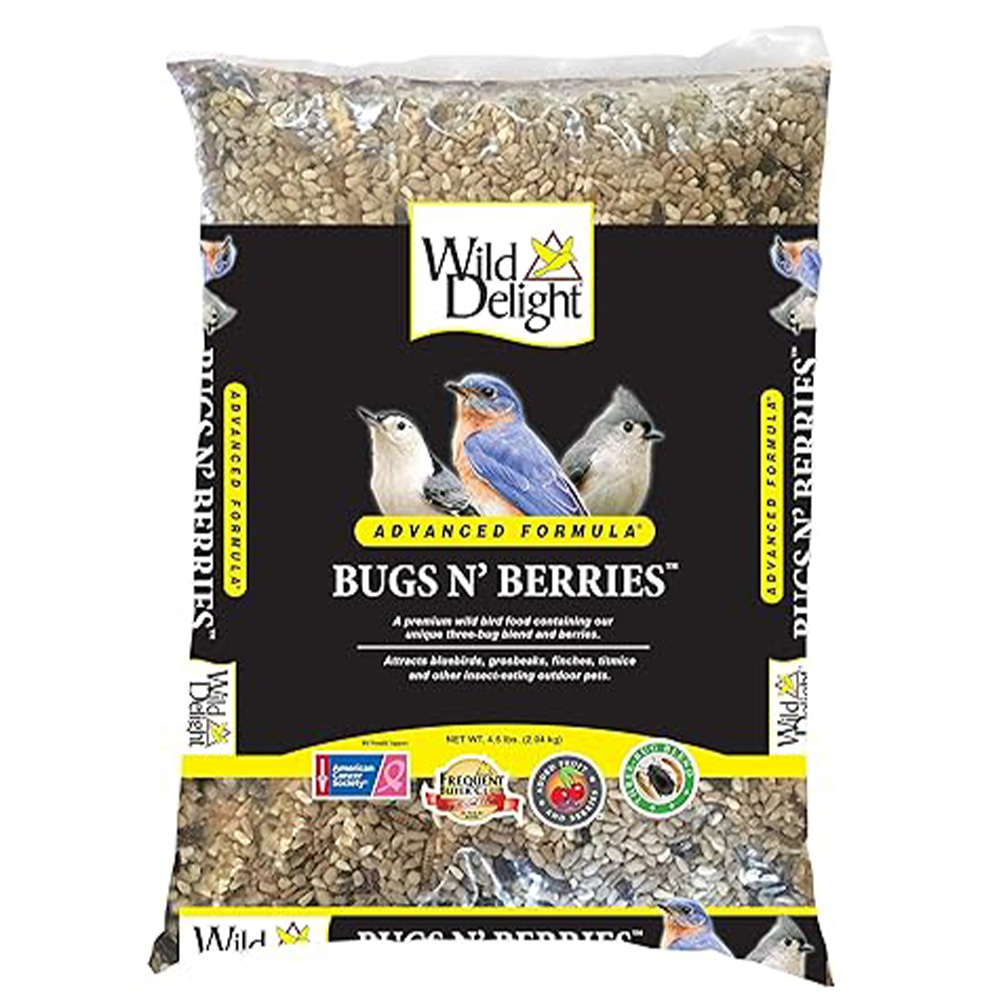
Best for insects
This wild bird food contains a three-bug blend and, looking at the ingredients, it appears to consist of black soldier fly larvae, dehydrated mealworms and dried darkling beetles. These nestle within a bag that is predominately sunflower kernels and sunflower seeds along with raisins and dried cherries.
But there’s so much more in the bag from technical gelatin and mineral oil to dried milk protein and a heap of vitamins along with copper sulfate, manganous oxide and sodium bicarbonate to state just a few. There’s no millet, milo or corn so it’s free of filler but there does seem to be more processing involved than with some other products.
The company says it cleans the food to remove dust and debris and that it uses the same premium ingredients every time for consistency, however.
Reasons to buy: It’s a premium blend at a reasonable price that will attract bluebirds, finches and other small birds.
Reasons to avoid: The list of ingredients is a lengthy one and you may not be entirely comfortable with that.
How we chose the best bird food
While we stopped short of actually taking a taste-test, we looked for food that was natural, packed with nutrients and provided value for money. We considered which birds you would want to attract and the food that was likely to bring them to a feeder and we looked at the packets themselves. If they’re resealable, they’ll get an extra thumbs-up for freshness.
What do vets recommend as the best bird food?
When it comes to the best bird food, there is no one single solution. The answer to this question very much depends on the birds which come to your yard (so keep an eye out for the varieties) and the birds you want to attract. For the best advice, we turned to Dr Rebecca MacMillan and she recommended a host of different foods, namely:
Sunflower seeds: “These are popular with many birds and contain a variety of healthy fats,” Dr MacMillan says. “Sparrows, nuthatches, and blue tits all enjoy these. If you feed the shelled variety, bear in mind that birds can make a mess when eating them (due to the discarded shells).”
Peanuts: “These can be offered whole or in granules and they are popular with most garden birds. Whole peanuts should always be provided in a bird feeder to stop smaller species from taking larger pieces than they can safely manage.” Here’s some more info about feeding birds peanuts.
Nyger seeds: “Also known as nyjer or niger, these seeds are popular with sparrows, doves, finches, and bunting, but due to their size, they need to be offered in a finer-mesh feeder to stop the seeds from falling out.”
Suet: “Suet is great during the autumn and winter months when birds require more energy. Suet can be offered in balls from a suet feeder, in blocks, or set in coconut shells. Many birds enjoy these, but particularly woodpeckers, robins, and jays.” If you enjoy crafting, here’s how to make your own bird suet.
Mealworms: “You can buy mealworms alive or dried and they provide protein and fat to garden birds. Most species enjoy these, so they are a great addition to your feeding station. If offering dried mealworms during the breeding season, try soaking them first to make them easier for baby birds to eat.”
Is it important to leave water as well as food?
Absolutely. A clean supply of water is not only great for quenching a bird’s thirst, it also allows them to have a bath. “It is always a good idea to have water available for wild birds in your garden,” Dr MacMillan affirms. “This is important in the hot summer months, but also in the winter months when regular water sources might be frozen.”
But how should you present the water? It’s a good idea to keep it slightly away from the food so bits don’t end up falling in the water. “A large shallow bird bath or dish is preferable, as birds will use this to bathe in as well as drink from,” Dr MacMillan adds. “As with your bird feeders, you should clean this out regularly to avoid algae and bird droppings from contaminating the water.”
Can some bird food persuade birds to leave your plants alone?
Not really. There are no particular foods that will persuade birds to leave your plants alone. “But offering a varied selection of good quality bird food at your feeding station will help to keep them busy and less hungry,” Dr MacMillan says. “You should also look at protecting your plants and vegetables, for example by growing them under mesh or netting. Hanging shiny, spinning, or noisy objects nearby will also discourage them from attacking your plants.”

Dr Rebecca MacMillan is a companion animal vet who has always had a passion for writing and client communication. She works in the South West and loves complex medical cases.
Get the best advice, tips and top tech for your beloved Pets

David Crookes has been a journalist for almost 30 years and he has written for a host of magazines, newspapers, websites and books including the World of Animals Annual, BBC Earth, Live Science, The Independent and Tom’s Guide.
Born in England, he lives with two cats but he’s also keenly interested in the differences between the huge number of dog breeds – in fact, you can read many of his breed guides that he’s written in collaboration with vets here on PetsRadar.
With a lifelong passion for technology, too, he’s always on the lookout for useful devices that will allow people to keep their pets happier and healthier, and provide them more time to spend together.
David has a degree from Durham University, as well as postgraduate diploma in journalism from the University of Central Lancashire.
